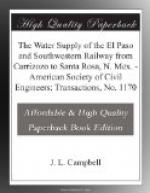From Fig. 2 it appears that, while the 10-in. line had an initial coefficient of roughness slightly greater than 0.009 and now equal to it, the 16-in. line had one equal at first but now slightly less than 0.01.
The line from Bonito Creek to Nogal Reservoir was to have a capacity of 5 sec-ft. Referring to the profile, it was determined that for the hydraulic grade of 33-1/3 ft. per 1000 ft., a 10-in. pipe was necessary, and that a 16-in. pipe was required for the grade of 3 ft. per 1000 ft.
Test No. 1.—On March 10th, 1908, a quantity of bran was poured into the upper end of the 10-in. pipe at A (Fig. 2), and the time of its appearance at the lower end of the 16-in. pipe at E was noted. The time was 3 hours and 50 min.
This gave:
Area of 10-in. pipe = 0.5454 sq. ft.
" " 16 " " = 1.3960 "
"
Length " 10 " " = 13,200 ft.
" " 16 " " = 47,500 "
Time, = 13,800 sec.
Let x = velocity of flow in 16-in. pipe, in feet per second, then 2.56 x = velocity of flow in 10-in. pipe, in feet per second.
From which:
13,200 47,500 ------- + ------- = 13,800 2.56_x_ x
x = 3.805
and 2.56_x_ = 9.740
The discharge is:
For the 16-in. pipe, 1.396 x 3.805 = 5.31 cu. ft. per sec.; and, for the 10-in. pipe, 0.5454 x 9.74 = 5.31 cu. ft. per sec.
The question arose as to whether or not the particles of bran in the water traveled as fast as the water flowed. It was also desired to check by observation the relative velocities in the two pipes, as above deduced.
Test No. 2.—To determine these points, a second test was made, on March 31st, 1908, twenty days after the first one. In this test, green aniline, red potassium permanganate, and bran were used. An observer was placed at the end of the 10-in. line at B (Fig. 2), and, by letting a small quantity of water run from a relief-valve there, he was able to note the time of the appearance of the colors and the bran.
The green was started in the upper end of the 10-in. pipe, at A (Fig. 2), at 8.30 A.M. It appeared at B in 22 min., and at E in 3 hours and 52 min.
The red was started at 8.45 A.M. It reached B in 21-1/2 min., but it was so faded that the time of its appearance at E could not be noted exactly.
The bran was started at 9.00 A.M. It reached B in 22 min., and appeared at E in 3 hours and 51 min.
From the average of these figures, the velocities were:
In the 16-in. pipe, 3.792 ft. per sec. " " 10 " " 9.695 " " "
and the discharges were:
In the 10-in. pipe, 5.287 cu. ft. per sec. " " 16 " " 5.293 " " " "
The application of the equation for equalized relative velocities, as in the first test, gives:




